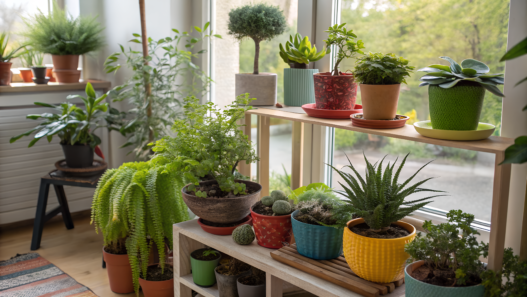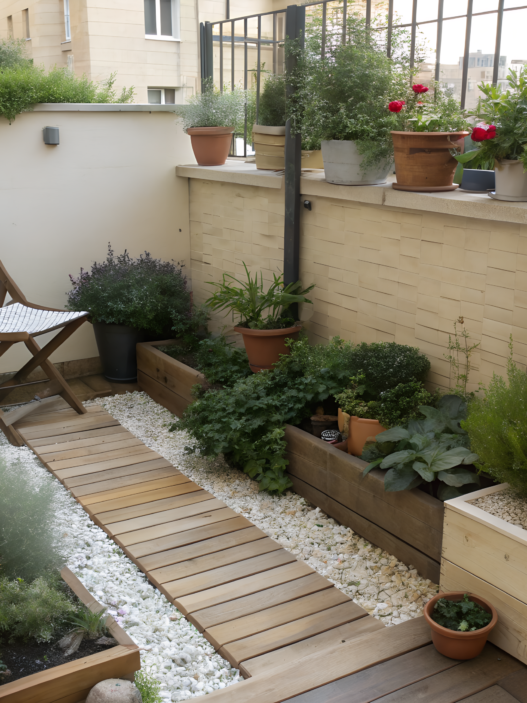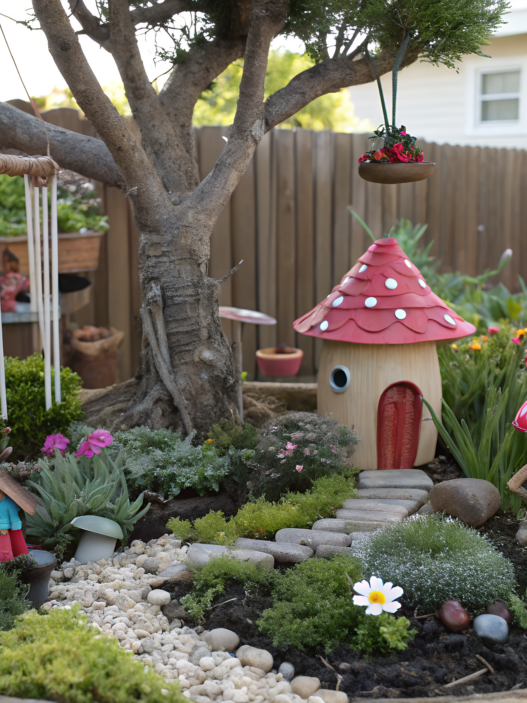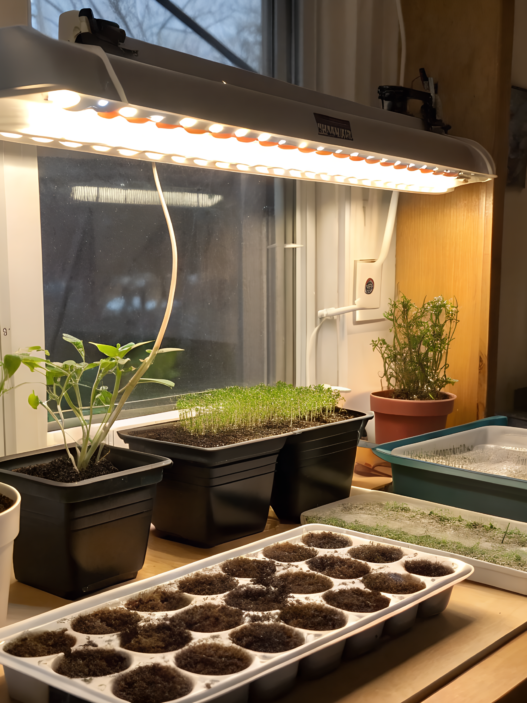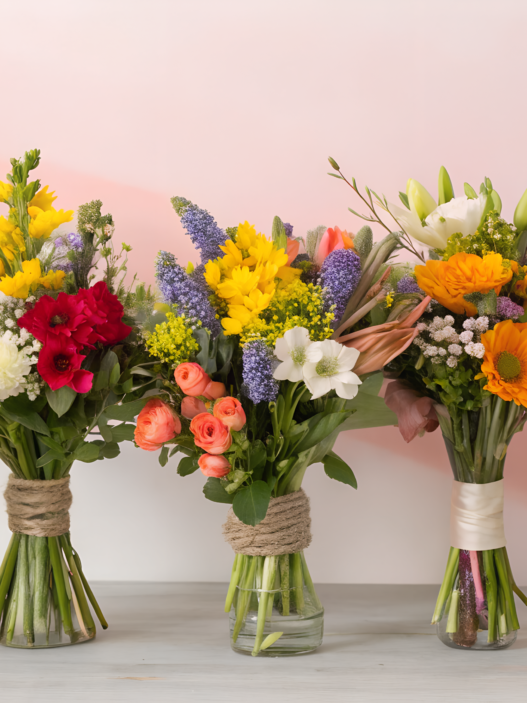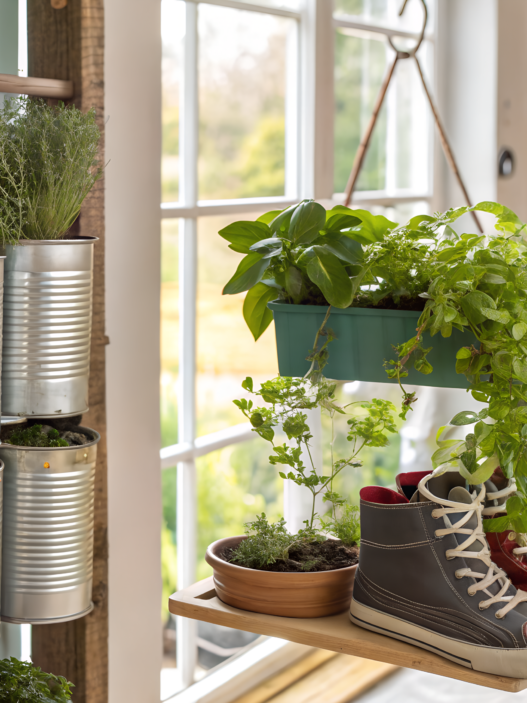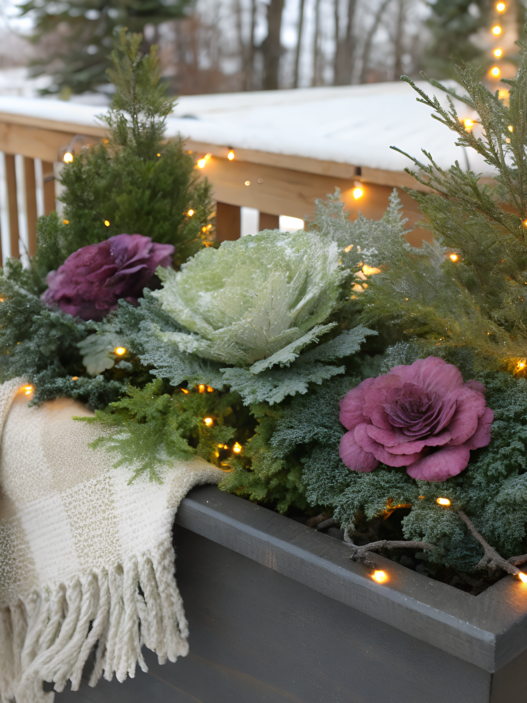Living in a small space doesn’t mean you have to give up gardening! These 10 indoor mini garden ideas are perfect for tiny apartments and compact homes, bringing greenery inside without taking up too much room.
1. DIY Indoor Herb Garden for Apartments: Fresh Flavors, No Space Needed

It’s always nice to have fresh herbs on hand – it’s convenient, tasty and beautiful. So even in a tiny kitchen you can organize a mini herb garden.
What do you need?
- A suitable place. A windowsill, wall shelf, hanging cachepots or a compact table are perfect for this purpose. If there is little light – LED-grow lamp (here is an example).
- Pots. Clay, plastic, or self-watering, your choice.
- Herbs. You can grow basil, thyme, mint – they grow quickly and require little care.
If space is tight, use wall-mounted planters or hanging containers.
How to plant and care for?
- Fill the pot with drainage and soil.
- Plant seeds or seedlings, lightly tamp the soil, and water.
- Water every 3-4 days (be careful not to flood the plants!).
- Fertilize every 2 weeks with organic fertilizer.
- Cut back herbs as they grow, but no more than 1/3 of the plant at a time.
- Cut back the flowers regularly to keep the plant from going to seed.
2. Hanging Indoor Mini Garden That Doubles as Home Decor

A hanging garden is a lifesaver for small apartments. It is not only beautiful, but also practical, because plants do not take up space on the floor, but at the same time decorate the interior and purify the air.
How to make a hanging garden?
- Choice of design
- Cachepots on macramé – a stylish and simple option.
- Wall shelves for pots – such an option is suitable for light plants, like succulents.
- Phytomodule – a ready-made system for vertical gardening (for example, this one).
- What plants should I choose?
- Ampel (hanging) plants: epipremnum, ivy, tradescantia, hoya. They look incredible as they cascade down.
- Domestic herbs: mint, thyme, parsley (it is desirable to place them closer to the kitchen).
- Succulents: sedum, clematis, kalanchoe – ideal for the lazy!
- Fixing and care
- Make sure the wall can support the weight of the plants and irrigation water.
- If pots without drainage, put expanded clay at the bottom.
- Water moderately, as water will run downhill.
3. Mini Greenhouse for Small Spaces: Grow Plants Anywhere

By the way, a mini greenhouse allows you to grow herbs, seedlings and even exotic plants at home. It retains heat and humidity, creating the perfect growing conditions.
Choosing a mini greenhouse
- Tabletop greenhouse. This is a compact option for the windowsill, great for herbs and seedlings. (See options)
- Etagere with transparent walls. It is convenient to put it on the balcony or in a bright room.
- Homemade greenhouse. This is a plastic container with a lid, drainage and ventilation, pots with plants are placed inside.
What can be grown?
- Herbs (basil, parsley, cilantro, mint) – grows best in a light, fertile mixture with peat and perlite, which retains moisture, but does not overwater the roots.
- Sprouts (tomatoes, peppers, eggplants) – need a loose, nutritious soil for sprouts, which will ensure rapid growth and development of the root system.
- Exotic plants (orchids, lemons, avocados) – require a mixture with coconut fiber or vermiculite to retain moisture and provide roots with air.
How to Care?
- Watering. Moisturize the soil moderately – don’t overwater, but don’t overdry either.
- Light. Good growth requires 6+ hours of sunlight or an LED grow lamp.
- Airing. Don’t forget about it and once a day open the lid for 10-15 minutes to avoid mold growth.
A mini greenhouse is a simple solution if you want greens all year round. Convinced?
4. Windowsill Indoor Mini Garden: The Easiest Way to Add Greenery Indoors
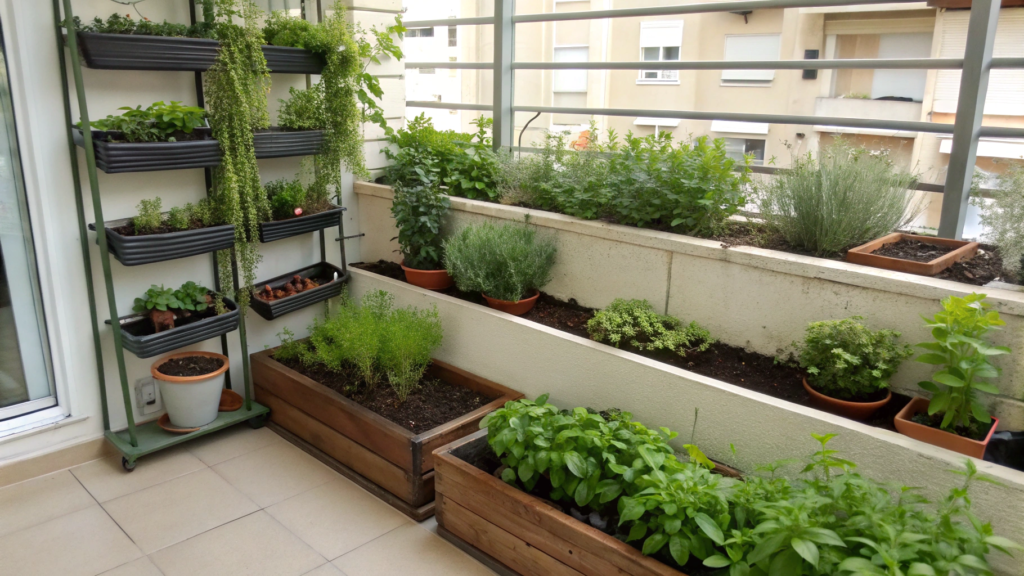
The windowsill is the perfect place for a mini garden. You can grow fragrant herbs, compact houseplants and even mini trees. The main thing is to organize the space correctly.
Which plants should I choose?
- Sun-loving plants. They include basil, thyme, rosemary, which grow well in light soil with peat and perlite and are convenient to grow in long boxes. Aloe, cacti and succulents prefer sandy substrate and ceramic pots with drainage. All these plants like light and grow quickly.
- Shade-loving plants. These are ferns, spathiphyllum, peperomia, need loose, moisture-intensive soil with coconut fiber. They feel good in the penumbra and even help purify the air.
How to organize the space?
- Use compact pots. Choose pots of the same size or mix different styles to create a more natural and organic look.
- Put tall plants closer to the wall and low plants in front so they don’t shade each other.
- Use tiered shelves and hanging planters if your windowsill is narrow.
- Add self-watering planters so you don’t have to worry about watering.
Tip. Water once every 7-10 days in winter and 1-2 times a week in summer. Do not put plants close to the glass in the heat – the leaves can burn.
If you arrange a mini-garden on the windowsill, you will see that it is beautiful, convenient and useful.
5. Indoor Mini Garden in a Jar: The Easiest DIY Ever

A mini garden in a jar is the perfect solution for those who don’t like to mess around with watering and replanting. This garden is virtually maintenance free, but it is very beautiful and compact.
The closed environment in such a garden creates its own microclimate. Moisture evaporates, settles on the walls of the jar and nourishes the plants again. This means that you will have to water such a mini garden in a jar very rarely.
Plants and soil
- Choose miniature types of plants, for example, moss, ferns – for them a loose, moisture-absorbing substrate with coconut fiber is suitable.
- And for cacti and succulents, choose a mixture of sand and peat.
How to assemble a mini-garden in a jar?
- Take a glass jar with a lid (even an old cucumber jar will do). The bigger the jar, the better for the plants.
- Create a drainage layer. Put small pebbles, pebbles or expanded clay at the bottom of the jar to avoid stagnant water.
- Add activated charcoal. A thin layer of charcoal prevents fungi from growing.
- Backfill the soil. About 2-5 cm, depending on the plants.
- Plant the plants. Gently place the roots, lightly tamp the soil.
- Decorate. Add pebbles, moss or figurines on top for beauty.
- Close the jar and put it in a bright place, but without direct sunlight.
Watering such a garden about once a month (if the inside is dry). For succulents – less often. Airing the garden should be once every 2-3 weeks, opening the jar for a couple of hours.
Put the jar in a bright place, but not in direct sunlight. If condensation appears, then it is necessary to open the lid for a few hours.
6. Hydroponic Indoor Mini Garden: No Soil, No Mess, Just Growth
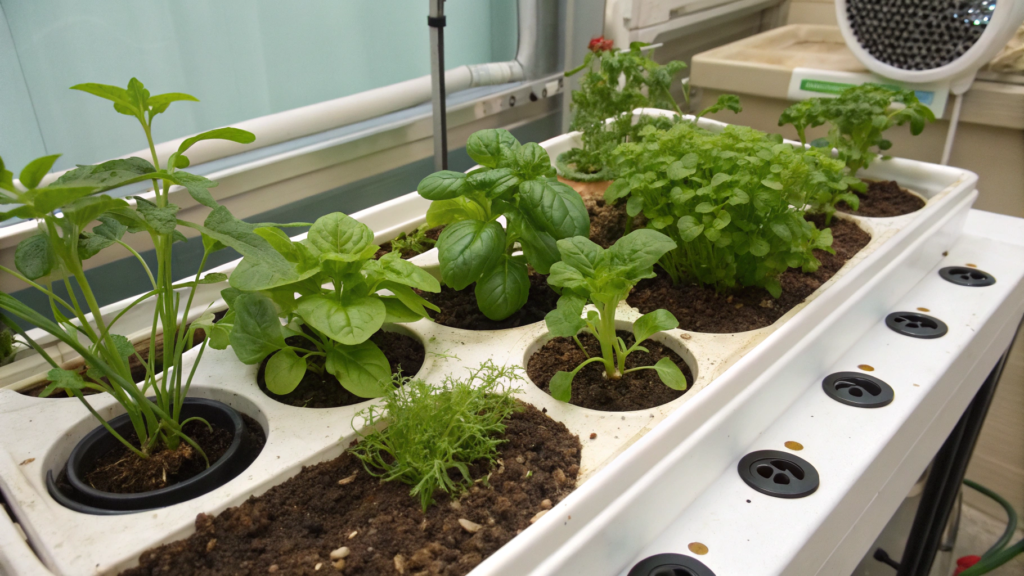
Imagine, you can grow fresh herbs, berries, and even vegetables… without soil! Yes, that’s hydroponics – a clever technology that allows plants to grow right in water, soaking up all the nutrients they need.
It sounds fantastic, but it’s a reality! Hydroponics mini beds take up little space, don’t require messy soil, and most importantly, allow for fast and healthy plant growth.
How it works:
Instead of soil, the roots of the plants are immersed in a nutrient solution that is automatically supplied by a special water circulation system. Thanks to this, the plants:
- Grow faster – they do not have to spend energy searching for nutrients in the soil.
- Do not suffer from drying out – the system regulates the moisture supply itself.
- Stay clean – no soil, mold or weeds!
Take note – this automatic hydroponic garden does everything for you!
With this system you can grow:
Greens: basil, spinach, arugula, cilantro, mint.
Leafy vegetables: lettuce, kale, chard.
Berries: strawberries, mini tomatoes.
Vegetables: sweet peppers, chili, mini cucumbers.
How to set up a hydroponic mini garden:
- Choose a system – there are compact tabletop models and full stands with lights.
- Add water and nutrient solution – this replaces soil and fertilizer.
- Set the plants – you can use special sponges or mini seedling cassettes.
- Turn on the system – the water will begin to circulate and the built-in LED lights will provide the perfect light.
- Watch the growth and in a couple of weeks you can harvest your first crop.
Hydroponic garden care:
- Refill the water once a week with fertilizer.
- Clean the system once a month to avoid sediment and algae.
- Prune plants to encourage new leaf growth.
A hydroponics mini bed is a modern and convenient solution for those who want maximum yield with minimal effort. So, have you been convinced to give it a try?
7. DIY Wall-Mounted Indoor Mini Garden for Vertical Living

Walls can be not just a backdrop, but a real green corner that will freshen up the interior without taking up precious space. A wall-mounted mini garden always looks stylish, functional and suitable for even the smallest apartments.
Which system to choose?
- Shelves or drawers – ideal for pots with herbs, spicy herbs or succulents.
- Suspended cachepots or macramé – for ampelike plants (ivy, traedescantia).
- Phytomodules – ready-made systems with pockets that create a green wall.
- Perforated panels (pegboard) – a universal solution, where you can attach pots, shelves and even lighting.
Choose any of these systems that will fit in well with your interior.
What plants should I choose?
Basil, mint, thyme are suitable for the kitchen. It is convenient to grow them in long boxes or pots. And in the living room will look great ivy, fern, philodendron in cascading hanging cachepots.
Chlorophytum, spathiphyllum like humidity, do not require special care, so it is better to grow them in the bathroom.
How to install and care?
- Choose a place – you need enough light, otherwise add LED-grow lamps.
- Install fixtures – shelves, cachepots or modular systems.
- Arrange plants in tiers – tall at the top, low at the bottom.
- Water moderately so there’s no sweat on the wall.
- Wipe dust off leaves once a month and rearrange pots for even growth.
Compact, stylish and easy to care for, this wall-mounted mini garden will liven up any interior.
8. How to Make a Coffee Table Indoor Mini Garden That Wows Guests

Imagine putting a cup of coffee on the table and in the center instead of boring decorations – a real live mini garden. Small, but eye-catching, because it is not only an original decoration, but also a way to bring a piece of nature into the interior.
And by the way, you can make it yourself! Or buy a ready-made version, if you do not want to mess with tools.
What you need?
- A table with a niche or glass tray – perfect for creating a built-in garden. If you don’t have a suitable table, you can simply use a low container or drawer in the center of a regular table.
- Succulents and cacti – miniature, virtually maintenance-free.
- Air plants (tillandsia, ferns) – don’t need soil, just place on rocks.
- Moss and low flowering plants – create the effect of a green carpet.
If the table is covered with glass, choose plants that do not need frequent watering.
How to assemble a mini-garden in a table?
- Create a base. If the table has an open space, put down a waterproof substrate (such as foil or a plastic tray).
- Add drainage. Lay out a layer of small pebbles or expanded clay to avoid moisture stagnation.
- Fill with potting soil. For cacti and succulents, sandy substrate is suitable, and for mosses – peat mixture.
- Plant the plants. Compactly arrange them to create a composition.
- Decorate. You can add stones, mini-figures or pieces of bark for coziness.
Water such a garden should be carefully, with a small amount of water once every 2-3 weeks. And if the glass fogs up, then open the lid, as the plants need airing.
To keep the garden looking fresh, wipe the glass and leaves clean of dust.
Would you put a table like this in your living room?
9. Indoor Mini Garden Succulent That Purifies the Air

Succulents are not just beautiful plants, they are natural filters that purify the air in your home. They absorb toxins, release oxygen and even reduce stress levels.
It is convenient to place such a mini garden of succulents on a desk or bookshelf. And all of this is virtually maintenance free. Sounds good, doesn’t it?
What do you need?
- Container – a wide, shallow pot or a glass terrarium.
- Plants – echeveria, aloe, crassula, Haworthia, sedum.
- Soil – light mixture with sand and perlite for drainage.
- Decor – pebbles, pebbles, tree bark.
Here is a set for beginners, which has everything you need
How to create a mini garden of succulents?
- Choose a container – a wide, shallow pot or even a glass terrarium will do.
- Add drainage – put a layer of stones or expanded clay at the bottom.
- Use the right soil – you need a light mixture of sand and perlite for good drainage.
- Arrange plants – alternate different shapes and colors to make the composition look natural.
- Add decor – you can use pebbles, tree bark.
- Water infrequently – once every 2-3 weeks with a small amount of water.
- Put in a bright place – they grow best on a sunny windowsill and periodically clean the leaves to better absorb oxygen.
10. Bookshelf Indoor Mini Garden: Turn Your Shelves into a Green Oasis

Bookshelves aren’t just for books! A mini garden on a shelf is a stylish and cute way to green up your interior without taking up too much space.
What you need?
- Containers – choose compact pots so they don’t clutter up the space, as well as hanging cachepots or self-watering containers.
- Plants – shade tolerant and unpretentious: ivy, chlorophytum, zamiokulkas, sansevieria, peperomia.
How to make?
- Choose a place – closer to the edge of the shelf for better light.
- Arrange by levels – tall plants on the edges, smaller ones between books.
- Add hanging pots or macramé if you can secure plants from above.
- Water moderately, avoiding stagnant water.
- Reposition plants once a month so they receive light evenly.
- If there’s not enough sun, add LED lights for the plants
A mini garden on a shelf is a compact and stylish solution for any interior.
Putting it all together
With these ideas, we can always bring nature inside our home. Choose any of them and ennoble your space with living and green magic.
Where do we start? Let me know in the comments – I’d love to know what’s growing in yours!
